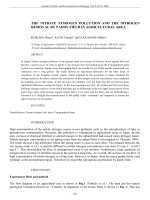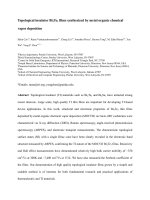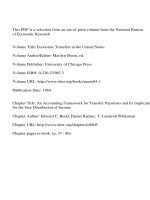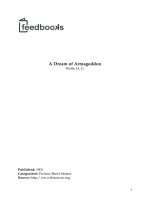The Darwinian Hypothesis by Thomas H. Huxley potx
Bạn đang xem bản rút gọn của tài liệu. Xem và tải ngay bản đầy đủ của tài liệu tại đây (6.13 MB, 79 trang )
The Project
Gutenberg EBook
of
The Darwinian
Hypothesis
by Thomas H.
Huxley
#16 in our series by
Thomas H. Huxley
Copyright laws are changing all over the
world. Be sure to check the copyright
laws for your country before downloading
or redistributing this or any other Project
Gutenberg eBook.
This header should be the first thing seen
when viewing this Project Gutenberg file.
Please do not remove it. Do not change or
edit the header without written
permission.
Please read the “legal small print,” and
other information about the eBook and
Project Gutenberg at the bottom of this
file. Included is important information
about your specific rights and restrictions
in how the file may be used. You can also
find out about how to make a donation to
Project Gutenberg, and how to get
involved.
**Welcome To The World of Free Plain
Vanilla Electronic Texts**
**eBooks Readable By Both Humans and
By Computers, Since 1971**
*****These eBooks Were Prepared By
Thousands of Volunteers!*****
Title: The Darwinian Hypothesis
Author: Thomas H. Huxley
Release Date: November, 2001 [Etext
#2927]
[Yes, we are more than one year ahead of
schedule]
[This HTML edition was first posted on
April 8, 2003]
Edition: 10
Language: English
*** START OF THE PROJECT
GUTENBERG EBOOK, THE
DARWINIAN HYPOTHESIS ***
This eBook was converted to HTML, with
additional editing, by Jose Menendez from
the text edition produced by Amy E.
Zelmer.
THE
DARWINIAN
HYPOTHESIS
*
BY
THOMAS H.
HUXLEY
DARWIN ON THE ORIGIN OF
SPECIES.
THERE is a growing immensity in the
speculations of science to which no
human thing or thought at this day is
comparable. Apart from the results
which science brings us home and
securely harvests, there is an
expansive force and latitude in its
tentative efforts, which lifts us out of
ourselves and transfigures our
mortality. We may have a preference
for moral themes, like the Homeric
sage, who had seen and known much:
—
“Cities of men
And manners, climates, councils,
governments”;
yet we must end by confession that
“The windy ways of men
Are but dust which rises up
And is lightly laid again,”
in comparison with the work of
nature, to which science testifies, but
which has no boundaries in time or
space to which science can
approximate.
There is something altogether out
of the reach of science, and yet the
compass of science is practically
illimitable. Hence it is that from time
to time we are startled and perplexed
by theories which have no parallel in
the contracted moral world; for the
generalizations of science sweep on in
ever-widening circles, and more
aspiring flights, through a limitless
creation. While astronomy, with its
telescope, ranges beyond the known
stars, and physiology, with its
microscope, is subdividing infinite
minutiae, we may expect that our
historic centuries may be treated as
inadequate counters in the history of
the planet on which we are placed.
We must expect new conceptions of
the nature and relations of its
denizens, as science acquires the
materials for fresh generalizations;
nor have we occasion for alarms if a
highly advanced knowledge, like that
of the eminent Naturalist before us,
confronts us with an hypothesis as
vast as it is novel. This hypothesis
may or may not be sustainable
hereafter; it may give way to
something else, and higher science
may reverse what science has here
built up with so much skill and
patience, but its sufficiency must be
tried by the tests of science alone, if
we are to maintain our position as the
heirs of Bacon and the acquitters of
Galileo. We must weigh this
hypothesis strictly in the controversy
which is coming, by the only tests
which are appropriate, and by no
others whatsoever.
The hypothesis to which we
point, and of which the present work
of Mr. Darwin is but the preliminary
outline, may be stated in his own
language as follows:—“Species
originated by means of natural
selection, or through the preservation
of the favoured races in the struggle
for life.” To render this thesis
intelligible, it is necessary to interpret
its terms. In the first place, what is a
species? The question is a simple one,
but the right answer to it is hard to
find, even if we appeal to those who
should know most about it. It is all
those animals or plants which have
descended from a single pair of
parents; it is the smallest distinctly
definable group of living organisms; it
is an eternal and immutable entity; it is
a mere abstraction of the human
intellect having no existence in nature.
Such are a few of the significations
attached to this simple word which
may be culled from authoritative
sources; and if, leaving terms and
theoretical subtleties aside, we turn to
facts and endeavour to gather a
meaning for ourselves, by studying the
things to which, in practice, the name
of species is applied, it profits us
little. For practice varies as much as
theory. Let the botanist or the
zoologist examine and describe the
productions of a country, and one will
pretty certainly disagree with the other
as to the number, limits, and
definitions of the species into which
he groups the very same things. In
these islands, we are in the habit of
regarding mankind as of one species,
but a fortnight’s steam will land us in
a country where divines and savants,
for once in agreement, vie with one
another in loudness of assertion, if not
in cogency of proof, that men are of
different species; and, more
particularly, that the species negro is
so distinct from our own that the Ten
Commandments have actually no
reference to him. Even in the calm
region of entomology, where, if
anywhere in this sinful world, passion
and prejudice should fail to stir the
mind, one learned coleopterist will
fill ten attractive volumes with
descriptions of species of beetles,
nine-tenths of which are immediately
declared by his brother beetle-
mongers to be no species at all.
The truth is that the number of
distinguishable living creatures almost
surpasses imagination. At least a
hundred thousand such kinds of insects
alone have been described and may be
identified in collections, and the
number of separable kinds of living
things is underestimated at half a
million. Seeing that most of these
obvious kinds have their accidental
varieties, and that they often shade
into others by imperceptible degrees,
it may well be imagined that the task
of distinguishing between what is
permanent and what fleeting, what is a
species and what a mere variety, is
sufficiently formidable.
But is it not possible to apply a
test whereby a true species may be
known from a mere variety? Is there
no criterion of species? Great
authorities affirm that there is—that
the unions of members of the same
species are always fertile, while those
of distinct species are either sterile,
or their offspring, called hybrids, are
so. It is affirmed not only that this is
an experimental fact, but that it is a
provision for the preservation of the
purity of species. Such a criterion as
this would be invaluable; but,
unfortunately, not only is it not
obvious how to apply it in the great
majority of cases in which its aid is
needed, but its general validity is
stoutly denied. The Hon. and Rev. Mr.
Herbert, a most trustworthy authority,
not only asserts as the result of his
own observations and experiments
that many hybrids are quite as fertile
as the parent species, but he goes so
far as to assert that the particular plant
Crinum capense is much more fertile
when crossed by a distinct species
than when fertilised by its proper
pollen! On the other hand, the famous
Gaertner, though he took the greatest
pains to cross the primrose and the
cowslip, succeeded only once or
twice in several years; and yet it is a
well-established fact that the primrose
and the cowslip are only varieties of
the same kind of plant. Again, such
cases as the following are well
established. The female of species A,
if crossed with the male of species B,
is fertile; but, if the female of B is
crossed with the male of A, she
remains barren. Facts of this kind
destroy the value of the supposed
criterion.
If, weary of the endless
difficulties involved in the
determination of species, the
investigator, contenting himself with
the rough practical distinction of
separable kinds, endeavours to study
them as they occur in nature—to
ascertain their relations to the
conditions which surround them, their
mutual harmonies and discordances of
structure, the bond of union of their
parts and their past history, he finds
himself, according to the received
notions, in a mighty maze, and with, at
most, the dimmest adumbration of a
plan. If he starts with any one clear
conviction, it is that every part of a
living creature is cunningly adapted to
some special use in its life. Has not
his Paley told him that that seemingly
useless organ, the spleen, is
beautifully adjusted as so much
packing between the other organs?
And yet, at the outset of his studies, he
finds that no adaptive reason
whatsoever can be given for one-half
of the peculiarities of vegetable
structure; he also discovers
rudimentary teeth, which are never
used, in the gums of the young calf and
in those of the foetal whale; insects
which never bite have rudimental
jaws, and others which never fly have
rudimental wings; naturally blind
creatures have rudimental eyes; and
the halt have rudimentary limbs. So,
again, no animal or plant puts on its
perfect form at once, but all have to
start from the same point, however
various the course which each has to
pursue. Not only men and horses, and
cats and dogs, lobsters and beetles,
periwinkles and mussels, but even the
very sponges and animalcules
commence their existence under forms
which are essentially
undistinguishable; and this is true of
all the infinite variety of plants. Nay,
more, all living beings march side by
side along the high road of
development, and separate the later
the more like they are; like people
leaving church, who all go down the
aisle, but having reached the door
some turn into the parsonage, others
go down the village, and others part
only in the next parish. A man in his
development runs for a little while
parallel with, though never passing
through, the form of the meanest
worm, then travels for a space beside
the fish, then journeys along with the
bird and the reptile for his fellow
travellers; and only at last, after a
brief companionship with the highest
of the four-footed and four-handed
world, rises into the dignity of pure
manhood. No competent thinker of the
present day dreams of explaining
these indubitable facts by the notion of
the existence of unknown and
undiscoverable adaptations to
purpose. And we would remind those
who, ignorant of the facts, must be
moved by authority, that no one has
asserted the incompetence of the
doctrine of final causes, in its
application to physiology and
anatomy, more strongly than our own
eminent anatomist, Professor Owen,
who, speaking of such cases, says (On
the Nature of Limbs, pp. 39, 40): “I
think it will be obvious that the
principle of final adaptations fails to
satisfy all the conditions of the
problem.”
But, if the doctrine of final
causes will not help us to comprehend
the anomalies of living structure, the
principle of adaptation must surely
lead us to understand why certain
living beings are found in certain
regions of the world and not in others.
The palm, as we know, will not grow
in our climate, nor the oak in
Greenland. The white bear cannot live
where the tiger thrives, nor vice
versa, and the more the natural habits
of animal and vegetable species are
examined, the more do they seem, on
the whole, limited to particular
provinces. But when we look into the
facts established by the study of the
geographical distribution of animals
and plants it seems utterly hopeless to
attempt to understand the strange and
apparently capricious relations which
they exhibit. One would be inclined to
suppose a priori that every country
must be naturally peopled by those
animals that are fittest to live and
thrive in it. And yet how, on this
hypothesis, are we to account for the
absence of cattle in the Pampas of
South America, when those parts of
the New World were discovered? It is
not that they were unfit for cattle, for
millions of cattle now run wild there;
and the like holds good of Australia
and New Zealand. It is a curious
circumstance, in fact, that the animals
and plants of the Northern Hemisphere
are not only as well adapted to live in
the Southern Hemisphere as its own
autochthones, but are in many cases
absolutely better adapted, and so
overrun and extirpate the aborigines.
Clearly, therefore, the species which
naturally inhabit a country are not
necessarily the best adapted to its
climate and other conditions. The
inhabitants of islands are often distinct
from any other known species of
animal or plants (witness our recent
examples from the work of Sir
Emerson Tennent, on Ceylon), and yet
they have almost always a sort of
general family resemblance to the
animals and plants of the nearest









